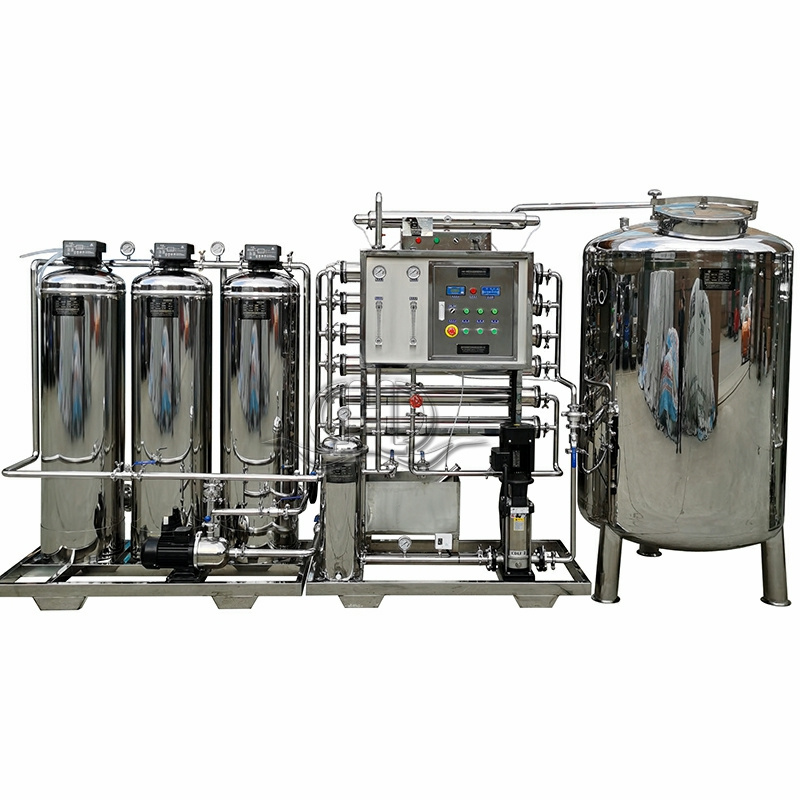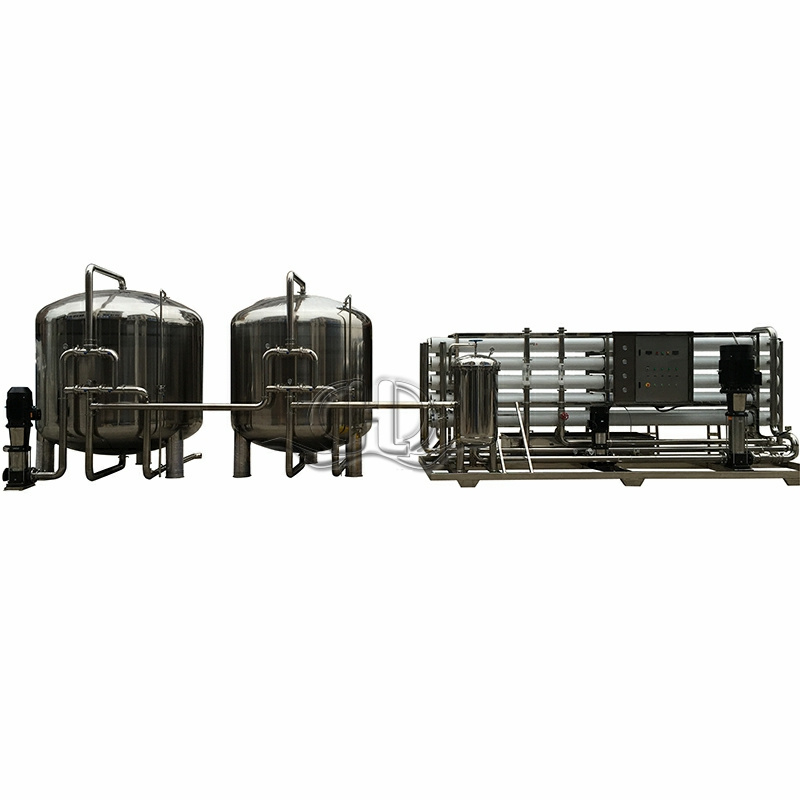Fully automatic two-stage reverse osmosis precision filtration system for reducing salinity in water filtration
Product description
1、 System core positioning and salt reduction principle
The fully automatic two-stage reverse osmosis precision filtration system is a deep desalination equipment designed for high salinity water quality (such as brackish water and industrial high salinity wastewater). Through a combination process of “two-stage reverse osmosis membrane series filtration+precision pretreatment+fully automatic control”, the total dissolved solids (TDS) in water are reduced from thousands or even tens of thousands of mg/L to below 10mg/L. The core principle is:
Primary reverse osmosis (RO1) desalination (desalination rate ≥ 97%), intercepting most of the salt;
Second stage reverse osmosis (RO2) deep desalination (desalination rate ≥ 99.5%) further purifies the first stage produced water, ultimately achieving a total desalination rate ≥ 99.9%, significantly reducing the salt content in the water.
2、 System composition and process flow
plaintext
Raw water → Pre treatment system (sand filtration+carbon filtration+precision filtration) → Primary reverse osmosis (RO1) → Intermediate water tank → Secondary reverse osmosis (RO2) → Pure water tank → Water point
1. Precision pre-processing system (ensuring membrane efficiency and lifespan)
Quartz sand filter:
Filter material: 0.5-1.2mm quartz sand, removes large suspended particles such as sediment and rust (particle size ≥ 20 μ m), reduces turbidity from 20NTU to ≤ 5NTU, and avoids scratching the RO membrane.
Fully automatic backwashing: triggered by pressure difference>0.05MPa or timed for 12 hours, with a water flushing intensity of 15L/(m ² · s), lasting for 5-10 minutes.
Activated carbon filter:
Filter material: Coconut shell activated carbon (specific surface area ≥ 1000m ²/g), capable of adsorbing residual chlorine (removal rate>99%), organic matter, and odors, ensuring that the residual chlorine in the RO membrane inlet water is ≤ 0.05mg/L (to prevent membrane oxidation).
Precision filter:
Filter element: 5 μ m PP melt blown filter element, which intercepts fine particles (5-20 μ m) and colloids remaining after pretreatment, making the influent SDI (pollution index) ≤ 3, and protecting the RO membrane from blockage.
2. First stage reverse osmosis (RO1, preliminary desalination)
Membrane components:
Type: Anti pollution bitter and salty water RO membrane (such as Dow BW30-400FR), with a single membrane desalination rate of ≥ 97% and a tolerance for influent TDS ≤ 5000mg/L.
Arrangement method: 6:3 two-stage design, with a recovery rate of 60% -70%, reducing the TDS of raw water from 5000mg/L to ≤ 150mg/L.
Core equipment:
High pressure pump: 316 stainless steel multi-stage centrifugal pump, providing 1.2-1.5MPa pressure, matched with variable frequency control, reducing energy consumption by 20%.
Automatic control: Low pressure flushing for 1 minute upon startup, chemical flushing for 5 minutes before shutdown to prevent scaling on the membrane surface.
3. Secondary reverse osmosis (RO2, deep desalination)
Membrane components:
Type: High desalination rate RO membrane (such as Dow BW30-440i), single membrane desalination rate ≥ 99.5%, for further purification of RO1 produced water (low salinity).
Operating parameters: operating pressure 0.8-1.0MPa, recovery rate 80% -85%, final water TDS ≤ 10mg/L, conductivity ≤ 20 μ S/cm.
Concentrated water reuse design:
RO2 concentrated water (TDS about 1000-2000mg/L) flows back to the inlet of RO1, increasing the total recovery rate of the system to 75% -80% and reducing wastewater discharge.
4. Fully automatic control system and water storage unit
PLC intelligent control:
Integrate pressure, flow, conductivity, and liquid level sensors to achieve automatic operation throughout the entire process:
Linkage control: start RO1 at low liquid level in the intermediate water tank, stop RO2 at high liquid level in the pure water tank;
Fault protection: automatic shutdown alarm in case of high voltage overload, low voltage water shortage, or excessive water production;
Automatic cleaning: When the pressure difference between RO1/RO2 is greater than 0.15MPa, the citric acid/sodium hydroxide cleaning program will automatically start.
Water storage unit:
Intermediate water tank (RO1 water production buffer): made of 304 stainless steel, with a capacity of 0.5 times the water production of RO1, to avoid frequent start stop of RO1;
Pure water tank: made of 304 stainless steel, equipped with a respirator (anti pollution) and a UV sterilizer (anti microbial) to ensure safe storage of pure water.
3、 Comparison of Salt Reduction Effect and Key Indicators
Pre treated raw water (brackish water) in the treatment stage, RO1 produces water and RO2 produces water (final)
TDS(mg/L) 5000-10000 4800-9800 ≤150 ≤10
Conductivity (μ S/cm) 8000-15000 7800-14800 ≤ 300 ≤ 20
Turbidity (NTU) ≤ 20 ≤ 1 ≤ 0.5 ≤ 0.1
Desalination rate – ≥ 97% Total desalination rate ≥ 99.9%
4、 Technical advantages and applicable scenarios
Core advantages
Deep salt reduction capability: Two stage RO series connection achieves a total desalination rate of ≥ 99.9%, capable of treating high salt water sources (TDS ≤ 10000mg/L), meeting the strict requirements of industries such as electronics and pharmaceuticals for low salt water quality;
Fully automatic unmanned operation: from pre-treatment backwashing to RO membrane cleaning, the entire process does not require manual intervention, suitable for remote areas or industrial continuous production scenarios;
Adequate membrane protection: three-stage pretreatment+anti fouling membrane design, membrane cleaning cycle extended to 12-18 months, with a service life of 3-5 years (traditional single-stage RO is 2-3 years);
Water and energy conservation: The concentrated water reuse design increases the total recovery rate of the system to 80%, and the variable frequency high-pressure pump reduces energy consumption to 2.5-3.5 kWh/m ³.
Applicable scenarios
Reuse of high salt wastewater: High salt wastewater (TDS 5000-10000mg/L) from industries such as chemical, printing and dyeing, and coal chemical is treated and reused for circulating cooling or process water;
Desalination of brackish water: In brackish water areas such as Northwest and North China (groundwater TDS 3000-8000mg/L), the produced water is used as drinking water or irrigation water;
Industrial high-purity water preparation: electronic chip cleaning (TDS ≤ 5mg/L), pharmaceutical injection water (conductivity ≤ 1.3 μ S)/ cm@25 ℃);
Island/Ship Water Supply: Processing of brackish or mild seawater near the sea (requires upgrading with high-pressure pumps), providing domestic water.
5、 Typical case: High salt wastewater reuse project in a chemical industrial park
Raw water quality: chemical wastewater (TDS 8000mg/L, conductivity 12000 μ S/cm, hardness 600mg/L);
System configuration: sand filter+carbon filter+5 μ m precision filter+primary RO (recovery rate of 65%)+secondary RO (recovery rate of 85%);
Running effect:
The final TDS of the produced water is ≤ 8mg/L, and the conductivity is ≤ 15 μ S/cm, meeting the standard for replenishing circulating cooling water;
The total recovery rate of the system is 78%, with a daily water production of 500 tons and an annual savings of 180000 tons of fresh water;
Fully automatic operation, requiring only one inspection per week, with a membrane cleaning cycle of 15 months.
6、 Selection suggestions
Small system (5-20m ³/h): suitable for laboratories and small chemical plants, covering an area of 15-30 square meters, with a power of 10-30kW;
Medium sized system (20-100m ³/h): suitable for industrial parks and brackish water desalination stations, equipped with 50-200m ³ pure water tanks, with a power of 30-100kW;
High hardness and high salt water source: Pre treat by adding a softener (such as sodium ion exchange) to prevent scaling of the RO membrane;
Ultra high standard requirement: EDI system can be added after RO2, with a water production resistivity of 15-18.2 M Ω· cm (ultra pure water level).
summarize
This system achieves deep desalination of high salt water quality through the collaborative design of “two-stage reverse osmosis+precision pretreatment”. It has the advantages of high efficiency, stability, and automation, and is the core equipment for solving the problem of high salt water source purification. It is widely used in the fields of industrial wastewater reuse, brackish water desalination, and high-purity water preparation.







